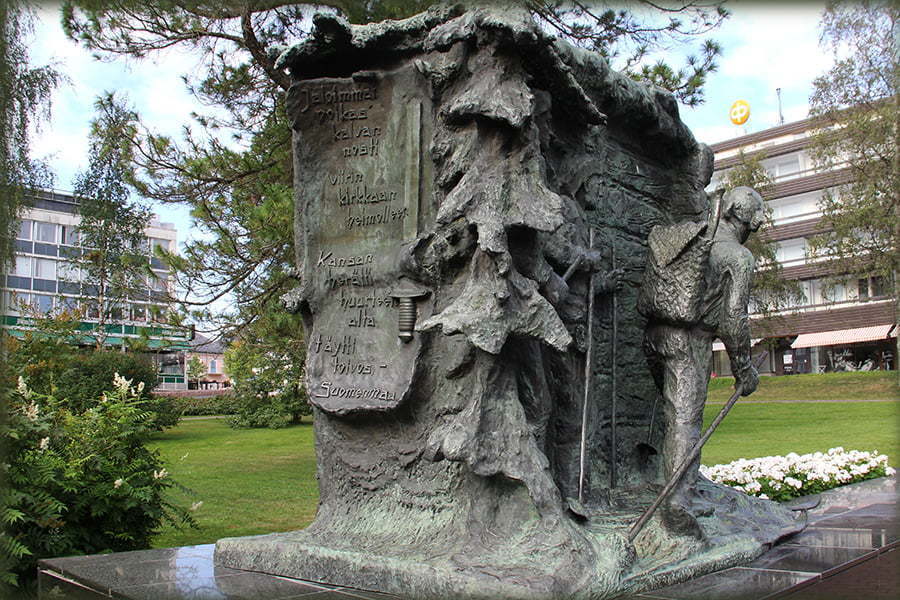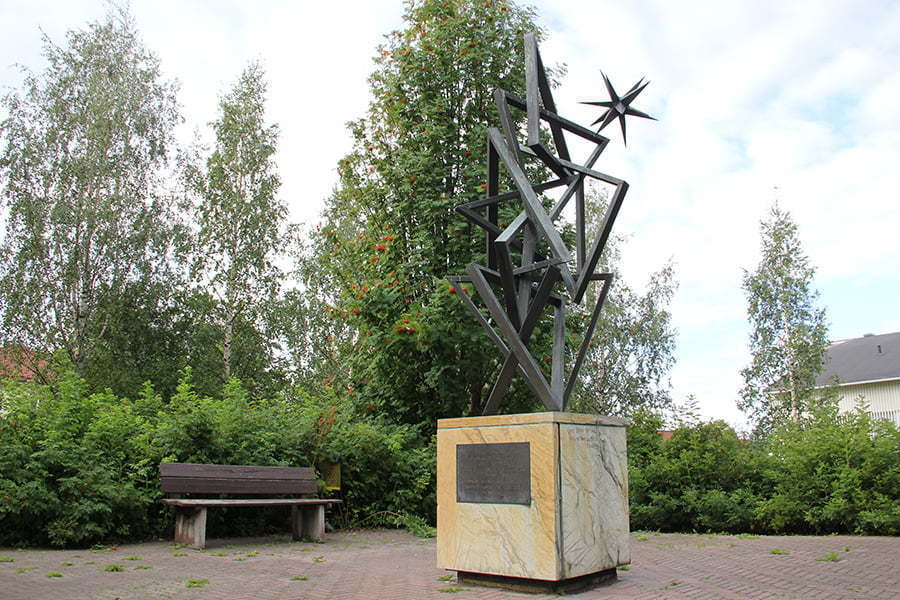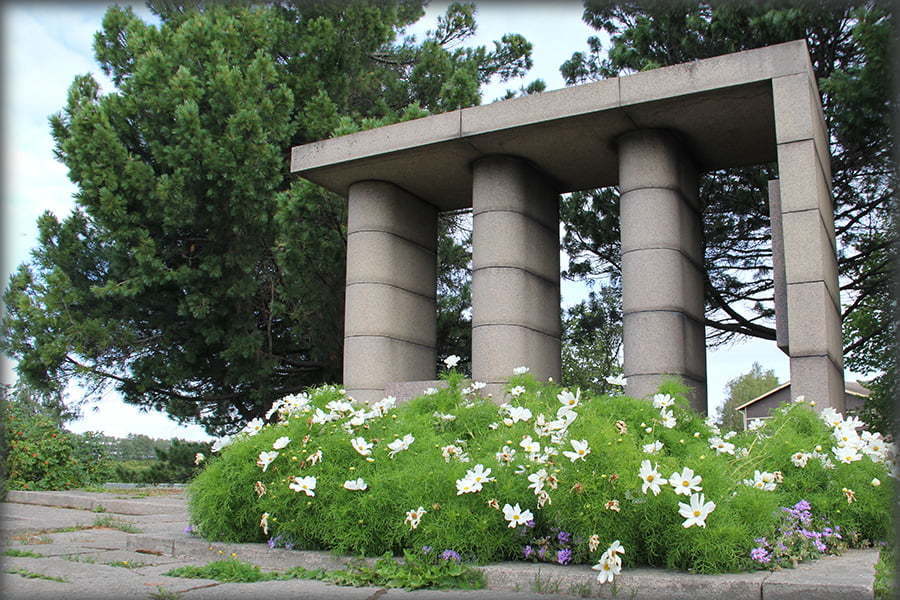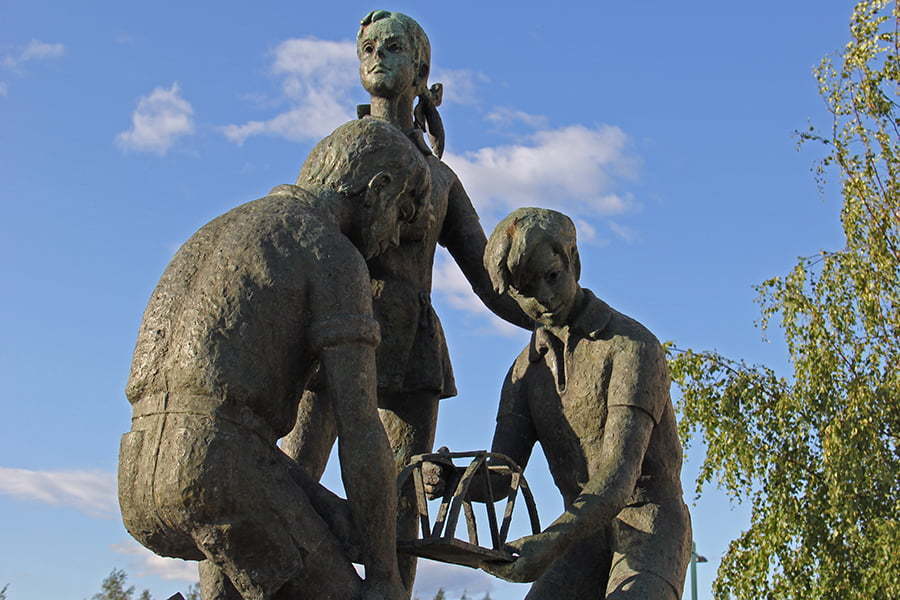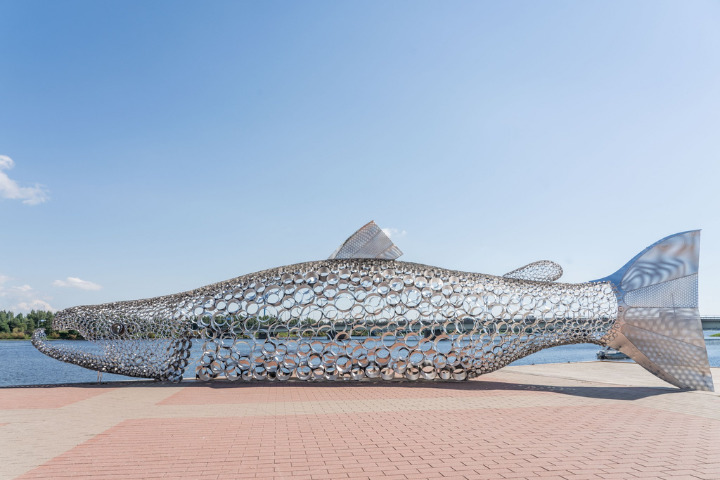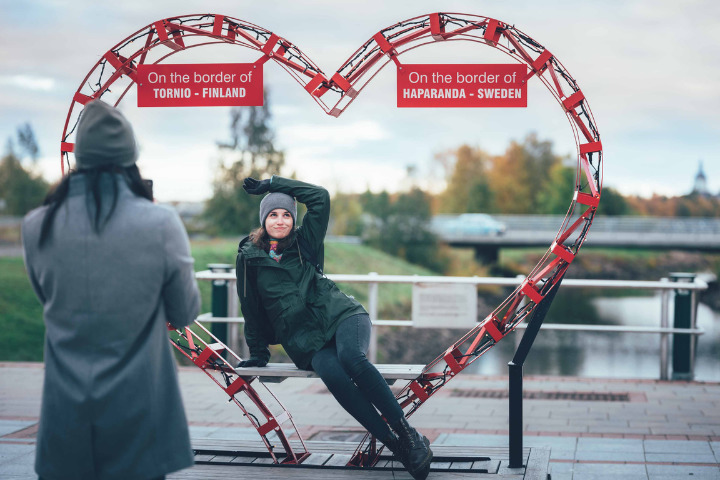Kojamo
Kojamo is a steel salmon statue in the heart of the city of Tornio on the Nordberg bluff, on the Torniojoki river next to the Pharmacy park. Kojamo is the work of the artist couple Pekka and Teija Isorättyä. At the heart of it is the essential freedom for the residents of the border area. It combines two important things for the city: steel and salmon. The statue was commissioned for its wonderful location in the city’s 400th anniversary in 2021. Next to Kojamo and inside you can get one of the best pictures of the city. The statue made of steel rings wonderfully reflects light at different times of the day and is illuminated at dark times of the year.
A Broken Lantern
“Särkynyt Lyhty”, a broken lantern, was also designed by Pekka and Teija Isorätty, and the piece was realized by the Tornio-based company Torstec Oy in 2013. It stands beautifully in Nordberg’s Möljä, next to the Kojamo statue. The work shows cult figures from Tornia, such as the priest of Kalkkimaa and the album cover of the band Terveet Kädet. The work is Tornioan through and through; it uses the locality’s own steel as well as steel objects collected from individuals and companies in the area.
Aino Statue
The Aino statue, in the park called Aino, is a belated representative of classic handicraft style. The statue was presented to the city of Tornio by the Kalevan Women of Tornio registered association. The bronze statue by Nina Sailo (1906–1988) was unveiled 19.7.1959. Park Aino is located in the center of the city.
The French Geodesic Mission memorial
This monument was erected in memorance of French academic Maupertuis’s expedition of 1736-1737. The Maupertuis expedition settled the argument of planet Earth’s shape. The measurements extended all the way from the church tower of Tornio to the Kittis fell of Pello. The measurements were conducted both in the southern hemisphere in Peru and the northern hemisphere close to the polar circle in Tornio valley. The tally man of the Maupertuis expedition, abbot Outhier, wrote an interesting and widely spread journal of Tornio and its river valley. In 1998 during the celebration of Maupertuis 300th birthday, the monument and the environment surrounding it was renovated and the park was named “Maupertuis park”. It is located nearby the Tornio church. The monument was designed by Olof Ericson and it was unveiled on 19.6.1971.
Statue of Eetu Isto (tombstone)
Eetu Isto was an artist born in Vojakkala in 1865 and is considered to be one of the most remarkable Finns of his time. He was known to be fighting for the rights of Finland during the 19th century. He painted his most renowned work “The attack” in Berlin on 1899. The February manifest had been recently given and the symbolic message of an impending threat towards Finland harmed the people of the country. Many people wanted an replica of the painting to their homes, not only in Finland but also in countries like: Sweden, USA and Hungary. The commisioner network spread replicas of the painting to the Finns, even to those living abroad. The statue is located in the Alatornio cemetary, it was unveiled in 1936.
The Jaeger Monument
The idea of a Jaeger monument was born in student nations at the Helsinki University during the great war. Finland had to get rid of Russia, but it had no army of its own and troops had to be trained. Sweden plead to its neutrality, but Germany as the opponent of Russia, agreed to start the training of Finnish troops. Tornio, as well as the entire northwestern region, became an important waypoint to Haparanda for the jaeger movement. From there, the German government financed the journey to the Lockstedt training camp. When the volunteers received the orders to mobilize to the German front on 3.5.1916, their unit was named the “Royal Prussian Jaeger Battalion 27”. The monument can be located in Apteekinpuisto. The sculptor was Niilo Savia and his work was unveiled on 11.7.1965.
The Battle of Kiviranta Memorial
In Kiviranta, on the Tornio-Muonio main road, the bloodiest battle of the Lapland war was fought between 4.10. – 8.10.1944. There were hundreds of casualties and wounded, and the Finnish troops captured approximately 400 German soldiers. The memorial can be found 2km north of Tornio. The designers were Yrjö Koskimäki & Ensio Seppänen. The unveiling took place on 10.6.1990
Cornestone, Tornio`s First Church Memorial
The first church of Tornio was built during the end of the 30 year war between the years 1642-1647. The foundation of the church was built by own hand. In 1644 professionals assisted with the project when the tower, walls and decoration were being constructed. On 11.7.1682, the church was destroyed in a fire caused by a lightning bolt. The new and current church was opened on 11.7.1687. The monument can be seen infront of the congregation building. It was designed by Matti Porkka and unveiled on 30.9.2001.
The Lapland War Artillery Memorial
During the critical days of the Röyttä landing and Tornio battles, the success of the Finns was hanging by the edge of the blade. The German military had very strong artillery support while the Finnish military lacked artillery support altogether. The ships that participated in the Röyttä landing were succesfully unloaded although they were being disrupted by the swell of the sea, the German artillery, 9 bombers, a 9 beafourt storm, preaviously sunken ships and a decaying pier. During the ferocious German attacks from north and south, the Tornio artillery had a decisive part to play. With the artillery support the German forces were compelled to pull back. The monument has been placed on the 3rd battery firing post and is one of the original guns that were used during the firing. The artillery memorial is situated at the Röyttä road, 7 km from the central. It was unveiled in 1987.
The Ferryman Statue
This statue is a symbol of hard work and courage, it embodies the spirit of the courageous ferrymen that braved the waters and streams of Tornio River, transporting goods on wooden rafts from the upper river domain under very dangerous conditions. The sawmill industry and many other livelihoods were heavily depending on the ferrymen. The statue was designed by Ensio Seppänen and the unveiling took place in 1961. This monument can be found in Kukkolankoski approx. 15 km north of Tornio.
Rajaleikki Monument
In 1621, Tornio was founded on an old marketplace that was well known all over the Kalott region. From Viena to Swedish Lapland, merchants would gather in Tornio for the market events. Although the conditions have changed, the market and co-operation tradition has lived on to this day. During Tornio’s 350th anniversary in 1971, the municipalities of Norrbotten endowed a monument to the city. This artwork embodies the versatile and future of the co-operation between the borders. The monument is located at the Kranni road and it was designed by Ensio Seppänen. It was unveiled on 5.9.1971.
Heart of the twin city
The shared heart of the twin cities is located in HaparandaTornio’s common Victoria Square. The square was inaugurated in 2015 by Crown Princess Victoria. This is the must place where you have to take a picture. If you are in the picture with a friend, one can sit inside the heart on the Finnish side and the other on the Swedish side.
The arc of the future
The border arch, designed by Vilma Styrman and completed in 2009, is also located at Victoria Square, which displays the colors of both Finland and Sweden.
The Olympic Flame Memorial
The 1952 Olympic games were held in Finland, originally the games were supposed to be held in 1940 but because of the the 2nd world war the games were not arranged at all. In 1952 the rebuilding of the country had almost been completed, people had been resettled and the war indemnities were all but paid. The Olympic flame was taken to Helsinki via Tornio, where the first torch games were arranged. The torch games became soon a tradition in the city. The Olympic Flame Memorial can be seen next to the Pohja Stadium, it was designed by Ensio Seppänen and the unveiling took place on 1954.
The Mail Trajectory Memorial
After the conventional traffic communications had been cut in Russia during the Great War, Finland became the “Gateway” between east & west. A 1,3 km long trajectory was built over the Tornio River between 1916-1917. Over 1 330 m of wired cable was attached from a timber tower to another. 45 baskets filled with letters and parcels would be transported between the towers over 17 m above the ground. The Mail Trajectory was in service for two years and no less than 27,7 million parcels where delivered during those years. When the construction of the railroad bridge was completed in 1919, the trajectory became useless and was dismantled. The monument was designed by Raisa Mesilaakso and it was unveiled on 16.9.1988. It is located 3 km away from the central by the old Röyttä road close to the Alatornio church.
Landmark 63
The war of Finland between Sweden and Russia in 1808-1809, moved the border of the nations to Tornio River. The first landmark was erected to the northern corner of Kilpisjärvi close to the landmark of Norway and Sweden. 67 landmarks were built to both sides of the border. They were constructed of either wood or stone and marked with a number and the innitials of the countrys ruler’s name. The most important landmarks had also the coat of arms carved to them. Landmark 63 is located at the Näränperä customs road.
Röyttä Landing Memorial
The Lapland war started originally as a shadow war, where the date for the withdrawal of the German forces had been settled with the Finns. The Soviets however found out about the agreement and demanded immediate action from the Finns. The most decisive of these was the Röyttä landing. Three ships in Oulu were loaded with divisions consisting of 2 900 soldiers and the first wave of the landing arrived at the Röyttä harbor on 1.10.1944. The operations in Tornio started, and the Germans didn’t know where the divisions came from. Two additional waves were sent and when the fourth shipment was made, the German bombers had arrived and destroyed two Finnish ships. The Landing was a conspiracy of luck and courage. If fortune had turned it’s back on the Finns, the whole landing would have been a disaster. The memorial is located at the Kromi road approx. 2,5 km away from the central. Designed by Ensio Seppänen and unveiled in 1973.
War of Finland Monuments
Of all the wars fought between Sweden and Russia, the so-called war of Finland turned out to be the most fateful campaign from a Finnish perspective. After the Swedish army had suffered the decisive losses, they pulled back from Olkijoki on 31.11.1808 to Kemijoki, and a big catastrophe would befall them. The symptoms of a spreading disease had started to transpire amongst the troops to the south of Oulu. Approximately 250 men suffered from fatigue and froze to death during the trip to Kemijoki, the disease continued to ravage, even when the troops arrived in Tornio. By estimation, more than 2 000 soldiers perished within 2 weeks during the turn of the year 1808-1809. The dead were buried at first in ordinary cemeteries in Suensaari and Pirkkiö, but soon the gravediggers didn’t have the time to finish their work and because of this, regular pieces of soil were turned into cemeteries. Military graves can be seen in Elsanvainio, Virkamaa, Laivajärvi, Ruottala, Kaakamo and the Alatornio cemetary. Nine war monuments can be found in the Tornio-Haparanda region.
The great Northern War Monument
The great Northern war was fought during the years 1700-1721 between Sweden, Russia, Poland and Denmark. The conclusion of the war happened in the southern fronts, where Sweden lost the battles. The most decisive battle was fought in Poltava on 28.6.1709, after the loss the king of Sweden Karl XII fled to Turkey and Sweden’s emperial status began to crumble. In 1715 the Russians had occupied Finland, all the way to Kemi, this occupation marked the beginning of the Great Hate in Finland. During the withdrawal, the Swedes had pulled out their troops from Finland, leaving the Kemijoki area vulnerable for enemy looting and ravaging. The Tornio valley area remained unoccupied, due to the resistance of peasants and civilians. These groups formed voluntary divisions and repelled the enemy by force. The biggest foiling of an attack took place in Kaakamo on 15.3.1715, when a division of 500 Kazaks marched in to a motti set up by the Finns, their losses were great and the Kazaks fled. The monument was unveiled on 11.7.1982 and can be found in Kaakamo.
Tornio Battle Memorial
When Finland became independent on 6.12.1917 and it was acknowledged by Russia on 31.12.1917, the national consensus was lost. The people were divided into two different factions, the whites and the reds, and soon a bloody civil war broke out between them. Russians still residing in the country would choose the red faction, which means that a conflict with Russia was inevitable. One of the civil war battles were fought in Tornio on 6.2.1918. The battle was fought outside the old railway station, where the whites took on a Russian division. Both sides lost 9 men. The monument was designed by P. Riihimaa and it was unveiled in 1938.

